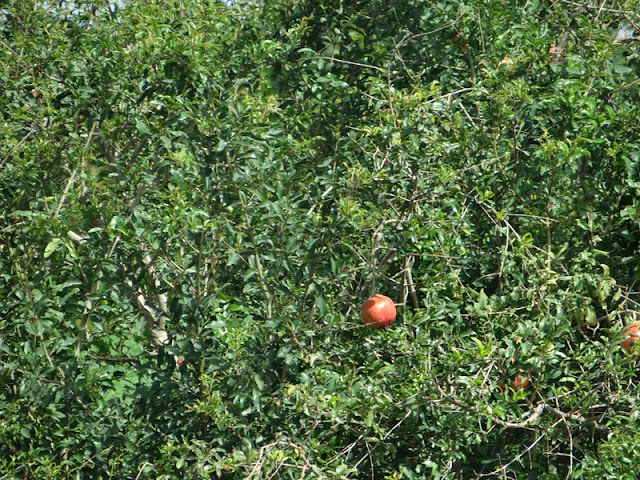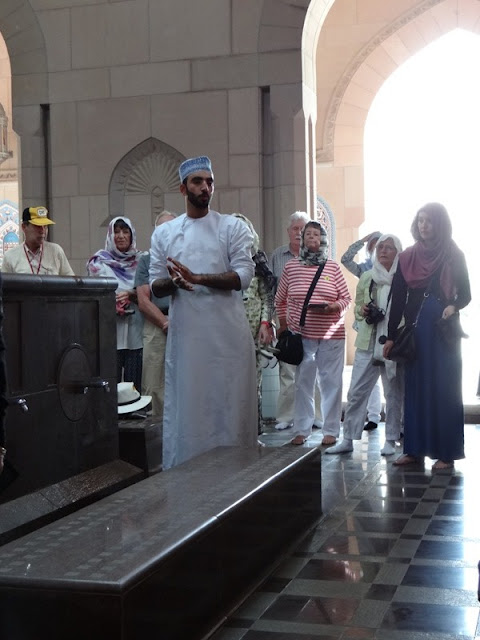Muscat, Oman
| Muscat مسقط Masqaṭ |
|
|---|---|
| Metropolis | |

Muscat Gate
|
|
| Location of Muscat in Oman | |
| Coordinates: 23°36′N 58°35′E / 23.600°N 58.583°ECoordinates: 23°36′N 58°35′E / 23.600°N 58.583°E | |
| Country | |
| Governorate | Muscat |
| Government | |
| • Type | Absolute monarchy |
| • Sultan | Qaboos bin Said |
| Area | |
| • Metro | 3,500 km2 (1,400 sq mi) |
| Population (May 2015) | |
| • Density | 368/km2 (950/sq mi) |
| • Metro | 1,560,000 [1] |
| Time zone | GST (UTC+4) |
| Website | Muscat Municipality |
The rocky Western Al Hajar Mountains dominate the landscape of Muscat. The city lies on the Arabian Sea along the Gulf of Oman and is in the proximity of the strategic Straits of Hormuz. Low-lying white buildings typify most of Muscat's urban landscape, while the port-district of Muttrah, with its corniche and harbour, form the north-eastern periphery of the city. Muscat's economy is dominated by trade, petroleum and porting.
Leaving the port
The Sultan - as the guide said, "May he live forever"
Our guide, much more conservative than the guide for my tour in 2012
The real fruit in the Garden of Eden
First glimpse of the mosque
Warder to make sure females were properly dressed = covered
Sultan Qaboos Grand Mosque
From Wikipedia, the free encyclopedia
| Sultan Qaboos Grand Mosque | |
|---|---|
 |
|
| Basic information | |
| Location | |
| Affiliation | Islam |
| Country | Oman |
| Architectural description | |
| Architectural style | Contemporary Islamic |
| Completed | May 2001 |
| Specifications | |
| Capacity | 20,000 |
| Minaret(s) | 5 |
Construction
The mosque is built from 300,000 tonnes of Indian sandstone. The main musalla (prayer hall) is square (external dimensions 74.4 x 74.4 metres) with a central dome rising to a height of fifty metres above the floor.[3] The dome and the main minaret (90 metres) and four flanking minarets (45.5 metres) are the mosque’s chief visual features. The main musalla can hold over 6,500 worshippers, while the women’s musalla can accommodate 750 worshipers. The outer paved ground can hold 8,000 worshipers and there is additional space available in the interior courtyard and the passageways, making a total capacity of up to 20,000 worshipers.[4]
The mosque is built on a site occupying 416,000 square metres[3] and the complex extends to cover an area of 40,000 square metres. The newly built Grand Mosque was inaugurated by Sultan of Oman on May 4, 2001.
Washing hands and feet before entering the mosque
The basin is full of moth balls - camphor - to cover the smell of thousands of feet
From Wikipedia:
A major feature of the design of the interior is the prayer carpet which covers the floor of the prayer hall. It contains, 1,700,000,000 knots, weighs 21 tonnes and took four years to produce, and brings together the classical Persian Tabriz, Kashan and Isfahan design traditions. 28 colors in varying shades were used, the majority obtained from traditional vegetable dyes. It is the second largest single piece carpet in the world. This hand-woven carpet was produced by Iran Carpet Company (ICC) at the order of the Diwan of the Royal Court of Sultanate. The carpet measures over 70 × 60 meters, and covers the 4,343 square meter area of the praying hall.
These designs would be fun to embroider
On the way to the souk
An Englishman blends in - sort of
The Sultan's yacht next to a more modest craft
At the museum
Home, sweet home
Roses from the florist aboard - a belated birthday present






























































No comments:
Post a Comment